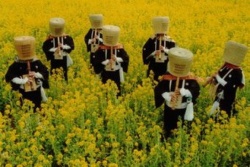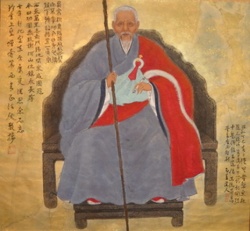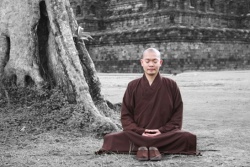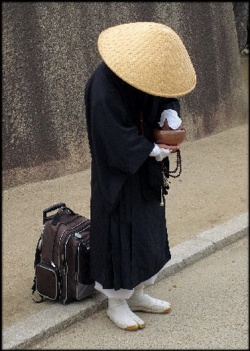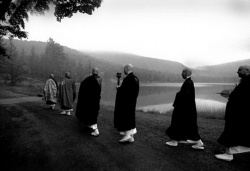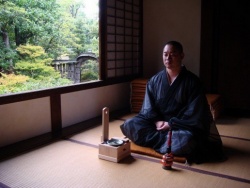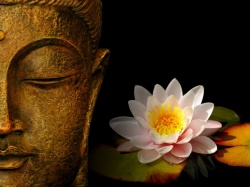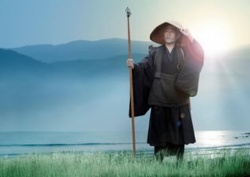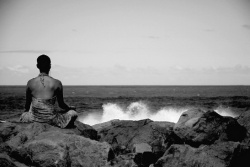Zen lineage charts
Zen lineage charts depict the transmission of the dharma from one generation to another. They were first created during the Tang Dynasty.
History
- See also: Chinese Chán
The idea of a patriarchal lineage in Ch'an dates back to the epitaph for Fărú (法如 638–689), a disciple of the 5th patriarch Hóngrĕn (弘忍 601–674). In the Two Entrances and Four Acts and the Continued Biographies of Eminent Monks, Daoyu and Huike are the only explicitly identified disciples of Bodhidharma. The epitaph gives a line of descent identifying Bodhidharma as the first patriarch.
In the 6th century biographies of famous monks were collected. From this genre the typical Ch'an-lineage was developed:
- These famous biographies were non-sectarian. The Ch'an biographical works, however, aimed to establish Ch'an as a legitimate school of Buddhism traceable to its Indian origins, and at the same time championed a particular form of Ch'an. Historical accuracy was of little concern to the compilers; old legends were repeated, new stories were invented and reiterated until they too became legends.
D.T. Suzuki contends that Ch'an's growth in popularity during the 7th and 8th centuries attracted criticism that it had "no authorized records of its direct transmission from the founder of Buddhism" and that Ch'an historians made Bodhidharma the 28th patriarch of Buddhism in response to such attacks.
Lineages
From Shakyamuni to Bodhidharma
The earliest descriptions of the Chán-lineage evolved into a continuous lineage from Śākyamuni Buddha to Bodhidharma. The idea of a line of descent from Śākyamuni Buddha is the basis for the distinctive lineage tradition of the Chán school. The Denkoroku, "Transmission of the Light", written by Keizan, gives 28 patriarchs in this transmission
| SANSKRT | CHINESE | VIETNAMESE | JAPANESE | KOREAN | |
| 1 | Mahākāśyapa | 摩訶迦葉 / Móhējiāyè | Ma-Ha-Ca-Diếp | Makakashyo | 마하가섭 / Mahagasŏp |
| 2 | Ānanda | 阿難陀 / Ānántuó | A-Nan-Đà / A-Nan | Anan | 아난다 / Ananda |
| 3 | Śānavāsa | 商那和修 / Shāngnàhéxiū | Thương-Na-Hòa-Tu | Shonawashu | 상나화수 / Sanahwasa |
| 4 | Upagupta | 優婆掬多 / Yōupójúduō | Ưu-Ba-Cúc-Đa | Ubakikuta | 우바국다 / Ubagupta |
| 5 | Dhrtaka | 提多迦 / Dīduōjiā | Đề-Đa-Ca | Daitaka | 제다가 / Chedaga |
| 6 | Miccaka | 彌遮迦 / Mízhējiā | Di-Dá-Ca | Mishaka | 미차가 / Michaga |
| 7 | Vasumitra | 婆須密 / Póxūmì | Bà-Tu-Mật | Bashumitsu | 바수밀다 / Pasumilta |
| 8 | Buddhanandi | 浮陀難提 / Fútuónándī | Phật-Đà-Nan-Đề | Buddanandai | 불타난제 / Pŭltananje |
| 9 | Buddhamitra | 浮陀密多 / Fútuómìduō | Phục-Đà-Mật-Đa | Buddamitta | 복태밀다 / Puktaemilda |
| 10 | Pārśva | 婆栗濕婆 / Pólìshīpó | Bà-Lật-Thấp-Bà / Hiếp-Tôn-Giả | Barishiba | 협존자 / Hyŏpjonje |
| 11 | Punyayaśas | 富那夜奢 / Fùnàyèshē | Phú-Na-Dạ-Xa | Funayasha | 부나야사 / Punayasa |
| 12 | Ānabodhi / Aśvaghoṣa | 阿那菩提 / Ānàpútí | A-Na-Bồ-Đề / Mã-Minh | Anabotei | 마명 / Mamyŏng |
| 13 | Kapimala | 迦毘摩羅 / Jiāpímóluó | Ca-Tỳ-Ma-La | Kabimara | 가비마라 / Kabimara |
| 14 | Nāgārjuna | 龍樹 / Lóngshù | Long-Thọ | Ryusho | 용수 / Yongsu |
| 15 | Kānadeva | 迦那提婆 / Jiānàtípó | Ca-Na-Đề-Bà | Kanadaiba | 가나제바 / Kanajeba |
| 16 | Rāhulata | 羅睺羅多 / Luóhóuluóduō | La-Hầu-La-Đa | Ragorata | 라후라다 / Rahurada |
| 17 | Sanghānandi | 僧伽難提 / Sēngqiénántí | Tăng-Già-Nan-Đề | Sōgyanandai | 승가난제 / Sŭngsananje |
| 18 | Sanghayaśas | 僧伽舍多 / Sēngqiéshèduō | Tăng-Già-Da-Xá | Sogyayasha | 가야사다 / Kayasada |
| 19 | Kumārata | 鳩摩羅多 / Jiūmóluóduō | Cưu-Ma-La-Đa | Kumarada | 구마라다 / Kumarada |
| 20 | Śayata | 闍夜多 / Shéyèduō | Xà-Dạ-Đa | Jayana | 사야다 / Sayada |
| 21 | Vasubandhu | 世親 / Shìqīn | Bà-Tu-Bàn-Đầu | Bashyubanzu | 바수반두 / Pasubandu |
| 22 | Manorhita | 摩拏羅 / Mónáluó | Ma-Noa-La | Manura | 마나라 / Manara |
| 23 | Haklenayaśas | 鶴勒夜那夜者 / Hèlèyènàyèzhě | Hạc-Lặc-Na | Kakurokuyasha | 학륵나 / Haklŭkna |
| 24 | Simhabodhi | 師子菩提 / Shīzǐpútí | Sư-Tử-Bồ-Đề / Sư-Tử-Trí | Shishibodai | 사자 / Saja |
| 25 | Vasiasita | 婆舍斯多 / Póshèsīduō | Bà-Xá-Tư-Đa | Bashashita | 바사사다 / Pasasada |
| 26 | Punyamitra | 不如密多 / Bùrúmìduō | Bất-Như-Mật-Đa | Funamitta | 불여밀다 / Punyŏmilta |
| 27 | Prajñātāra | 般若多羅 / Bānruòduōluó | Bát-Nhã-Đa-La | Hannyatara | 반야다라 / Panyadara |
| 28 | धर्म / Dharma | 達磨 / Dámó | Đạt-Ma | だるま / Daruma | 달마 / Dalma |
Six patriarchs
The earliest lineages described the lineage from Bodhidharma to Huineng. There is no generally accepted 7th Chinese Patriarch.
The principle teachers of the Chan and Zen traditions are commonly known in English translations as Patriarchs, however the more precise terminology would be "Ancestors" or "Founders" (祖, zu3) and "Ancestral Masters" or "Founding Masters" (祖師, zu3shi1) as the commonly used Chinese terms are gender neutral. Various records of different authors are known, which give a variation of transmission lines:
| The Continued Biographies of Eminent Monks Xù gāosēng zhuàn 續高僧傳 of Dàoxuān 道宣 (596-667) |
The Record of the Transmission of the Dharma-Jewel Chuán fǎbǎo jì 傳法寶記 of Dù Fěi 杜胐 |
History of Masters and Disciples of the Laṅkāvatāra-Sūtra Léngqié shīzī jì 楞伽師資紀記 of Jìngjué 淨覺 (ca. 683 - ca. 650) |
The Xiǎnzōngjì 显宗记 of Shénhuì 神会 | |
| 1 | Bodhidharma | Bodhidharma | Bodhidharma | Bodhidharma |
| 2 | Huìkě 慧可 (487? - 593) | Dàoyù 道育 | Dàoyù 道育 | Dàoyù 道育 |
| Huìkě 慧可 (487? - 593) | Huìkě 慧可 (487? - 593) | Huìkě 慧可 (487? - 593) | ||
| 3 | Sēngcàn 僧璨 (d.606) | Sēngcàn 僧璨 (d.606) | Sēngcàn 僧璨 (d.606) | Sēngcàn 僧璨 (d.606) |
| 4 | Dàoxìn 道信 (580 - 651) | Dàoxìn 道信 (580 - 651) | Dàoxìn 道信 (580 - 651) | Dàoxìn 道信 (580 - 651) |
| 5 | Hóngrěn 弘忍 (601 - 674) | Hóngrěn 弘忍 (601 - 674) | Hóngrěn 弘忍 (601 - 674) | Hóngrěn 弘忍 (601 - 674) |
| 6 | - | Fǎrú 法如 (638-689) | Yuquan Shenxiu 神秀 (606? - 706) | Huìnéng 慧能 (638-713) |
| Yuquan Shenxiu 神秀 (606? - 706) 神秀 | Xuánzé 玄賾 | |||
| 7 | - | - | - | Xuánjué 玄覺 (665-713) |
Tang Dynasty
Hongren - Huineng - Northern School - Shitou-lineage - Mazu-lineage - Southern School
- See also: East Mountain Teaching
The period of Daoxin (道信 580–651) and Daman Hongren (弘忍 601–674) came to be called the East Mountain Teaching, due to the location of the residence of Hongren at Huamgmei. The term was used by Shenxiu, the most important successor to Hongren.
Shenxiu (神秀 606?-706) was the most important successor to Hongren. In 701 he was invited to the Imperial Court by Empress Wu, who paid him due imperial reverence. The first lineage documents were produced in this period.
According to tradition, the sixth and last ancestral founder, Huineng (惠能; 638–713), was one of the giants of Chán history, and all surviving schools regard him as their ancestor. Shenhui, a successor to Huineng claimed Huineng to be the successor of Hongren's, instead of the then publicly recognized successor Shenxiu. The most prominent of the successors of Shenhui's lineage was Guifeng Zongmi
Shenhui's influence is traceable in the Platform Sutra, which gives a popular account of the story of Huineng, but also reconciles the antagonism created by Shenhui. Shenhui himself does not figure in the Platform Sutra; he was effectively written out of Chán-history.
| Predecessors | ||||
| 5 | Daman Hongren (601-674)(5th Patriarch) (WG Ta-man Hung-jen, Jpn. Gunin) | |||
| 6 | Yuquan Shenxiu (605?-706) (WG Yü-Ch'uan shen-hsiu, Jpn. Jinshū) |
Huineng (638-713) (WG Hui-neng, Jpn. Enō) | ||
| 7 | Northern School | Qingyuan Xingsi (660-740) (WG Ch'ing-yüan Hsing-ssu, Jpn. Seigen Gyōshi) |
Nanyue Huairang (677-744) (wg Nan-yüeh Huai-jang, Jpn. Nangaku Ejō) |
Heze Shenhui (WG Ho-tse Shen-hui, Jpn. Kataku Jin'e) |
| 8 | Shitou Xiqian (700-790) (WG Shih-t'ou Hsi-ch'ien, Jpn. Sekitō Kisen) |
Mazu Daoyi (709-788) (WG Ma-tsu Tao-i, Jpn. Baso Dōitsu) |
Southern School (WG Ho-tse School, Jpn. Kataku School) | |
| 9 | Fayan school Yunmen school Caodong school) |
Hongzhou school Linji school |
||
| Fifth generation: Guifeng Zongmi (780–841) ((圭峰 宗密 WG Kuei-feng Tsung-mi, Jpn. Keihō Shūmitsu) | ||||
Shitou Xiqian - Fayan School - Yunmen school - Caodong school - Soto school
- See also:Shitou Xiqian and Caodong school
The details of Shítóu's life are found in traditional biographies. Scholar Mario Poceski writes that Shítóu does not appear to have been influential or famous during his lifetime. Sayings to the effect that Shitou and Mazu were the two great masters of their day date from decades after their respective deaths. Shítóu's retrospective prominence owes much to the importance of Dongshan Liangjie, a 9th-century teacher who traced his lineage back to Shítóu.
| Six Patriarchs | ||||
| Huineng (638-713) (WG: Hui-neng. Jpn: Enō) | ||||
| Qingyuan Xingsi (660-740) (WG: TCh'ing yüan Hsing-ssu. Jpn: Seigen Gyōshi) | ||||
| 0 | Shitou Xiqian (700-790) (WG: Shih-t'ou Hsi-ch'ien. Jpn: Sekitō Kisen) | |||
| 1 | Tianhuang Daowu (748-807) (WG: T'ien-huang Tao-wu. Jpn: Tennō Dago) |
Yaoshan Weiyan (ca.745-828) (Yao-shan Wei-yen, Jpn. Yakusan Igen) | ||
| 2 | Longtan Chongxin (8th/9th century) (WG: Lung-t'an Ch'ung-hsin; Jpn: Ryūtan Sōshin) |
Yunyan Tansheng (780-841) (Yün-yen T'an-shen, Jpn. Ungan Donjō) | ||
| 3 | Deshan Xuanjian (782-865) (WG: Te-shan Hsüan-chien; Jpn: Tokusan Senkan) |
Dongshan Liangjie (807-869) Tung-shan liang-chieh, Jpn. Tōzan Ryōkai) | ||
| 4 | Xuefeng Yicun (822-908)(雪峰 义 存) (WG: Hsüeh-feng I-ts'un. Jpn: Seppō Gison) |
Caoshan Benji (840-901) (Ts'ao-shan Pen-chi, Jpn. Sōzan Honjaku) |
Yunju Daoying (d.902) (Yün-chü Tao-ying, Jpn. Ungo Dōyō) | |
| 5 | Jingqing Daotu (ca.863-937) (WG: Ching-ch'ing Tao-fu. Jpn: Kyōsei Dōfu) |
Yunmen Wenyan (864-949) (WG: Yün-men Wen-yen. Jpn: Ummon Bun'en) |
Caodong school | 8 generations |
| 6 | Xuansha Shibei (835-908) | Dongshan Shouchu (910-990) | Dōgen | |
| 7 | Luohan Guichen (867-928) | Yunmen school | Sōtō | |
| 8 | Fayan Wenyi (885-958) | |||
| 9 | Fayan school | |||
Mazu - Hongzhou school - Guiyang school - Linji school
Traditionally, Mazu is depicted as a successor in the lineage of Hui-neng, since his teacher Huairang is regarded as a student and successor of Huineng. This connection between Hui-neng and Nanyue Huairang is doubtfull, being the product of later rewritings of Chán-history to place Mazu in the traditional lineages.
Mazu is perhaps the most influential teaching master in the formation of Chán Buddhism in China. When Chán became the dominant school of Buddhism during the Song Dynasty, in retrospect the later Tang Dynasty and Mazu's Hongzhou school became regarded as the "golden age" of Chan.
The An Lu-shan Rebellion (755-763) led to a loss of control by the Tang dynasty, which changed the position of Chan. Metropolitan Chan began to lose its status, while...
- ...other schools were arising in outlying areas controlled by warlords. These are the forerunnersof the Chan we know today. Their origins are obscure; the power of Shen-hui's preaching is shown by the fact that they all trace themselves to Hui-neng.
The most important of these schools is the Hongzhou school (洪州宗) of Mazu, to which also belong Baizhang and Huangbo. The lineage of Linji (Rinzai), the founder of one of the Five Houses, is also traced back to Mazu.
| Six Patriarchs | |||
| Huineng (638-713) (Hui-neng, Jpn. Enō) | |||
| Nanyue Huairang (677-744) (Nan-yüeh Huai-jang, Jpn. Nangaku Ejō)) | |||
| Mazu Daoyi (709-788) (Ma-tsu Tao-i, Jpn. Baso Dōitsu) | |||
| Nanquan Puyuan (748-835) (Nan-ch'üan p'u-yüan, Jpn. Nansen Fugan) |
Baizhang Huaihai (720-814) (Pai-chang Huai-hai, Jpn. Hyakujō Ekai) | ||
| Zhaozhou Congshen (778--879) (Chao-chou Ts'ung-shen, Jpn. Jōshū Jūshin) |
Huangbo Xiyun (d.850) (Huang-po Hsi-yüan, Jpn. Ōbaku Kiun) |
Guishan Lingyou (771-853) (Kuei-shan Ling-yu, Jpn. Isan Reiyū) | |
| Linji Yixuan (d.866) (Lin-chi I-hsüan, Jpn. Rinzai Gigen) |
Guiyang school | ||
| Linji school | |||
Song Dynasty - The Five Houses of Chán
During the Song the Five Houses (Ch. 五家) of Chán, or five "schools", were recognized. These were not originally regarded as "schools" or "sects", but based on the various Chán-genealogies. Hhistorically they have come to be understood as "schools".
The Five Houses of Chán are:
- Guiyang school (潙仰宗), named after masters Guishan Lingyou (771–854) and Yangshan Huiji (813–890), dharma-descendants of Mazu Daoyi;
- Linji school (臨濟宗), named after master Linji Yixuan (died 866), who's lineage came to be traced back to Mazu, establishing him as the archetypal iconoclastic Chán-master;
- Caodong school (曹洞宗), named after masters Dongshan Liangjie (807–869) and Caoshan Benji (840–901);
- Yunmen school (雲門宗), named after master Yunmen Wenyan (died 949), a student of Xuefeng Yicun (822-908), whose lineage was traced back to Shitou Xiqian:
- Fayan school (法眼宗), named after master Fayan Wenyi (885–958), a "grand-student" of Xuefeng Yicun.
Guiyang school
- See also:Guiyang school
The Guiyang school (潙仰宗 Guíyáng, Jpn. Igyō) was the first established school of the Five Houses of Zen. Guiyang is named after master Guishan Lingyou (771–854) (Kuei-shan Ling-yu, Jpn. Isan Reiyū) and his student, Yangshan Huiji (807-883, or 813–890) (Yang-shan Hui-chi, Jpn. Kyōzan Ejaku). After founding the Guiyang School, Yangshan moved his school to what is now modern Jiangxi.
The Guiyang school was distinct from the other schools due to its use of esoteric metaphors and imagery in the school's kōans and other teachings.
| Six Patriarchs | |
| Huineng (638-713) (Hui-neng, Jpn. Enō) | |
| Nanyue Huairang (677-744) (Nan-yüeh Huai-jang, Jpn. Nangaku Ejō)) | |
| Mazu Daoyi (709-788) (Ma-tsu Tao-i, Jpn. Baso Dōitsu) | |
| Baizhang Huaihai (720-814) (Pai-chang Huai-hai, Jpn. Hyakujō Ekai) | |
| Guishan Lingyou (771-853) (Kuei-shan Ling-yu, Jpn. Isan Reiyū) | |
| Yangshan Huiji (807-883) (Yang-shan Hui-chi, Jpn. Kyōzan Ejaku) | |
| Guiyang school |
Fayan school and Yunmen school
- See also:Fayan school and Yunmen school
Via Xuefeng Yicun the Fayang school and Yunmen school are traced back to Shitou Xiqian and Huineng. Xuefeng was one of the most influential Chán-teachers at the end of the Tang Dynasty, when "a widely influential zen center formed around Xuefeng Yicun". The loss of control by the Tang Dynasty, and the accompanying loss of support for Buddhist institutions, lead to a regionally based Chan of Xuefeng and his students.
The Zutang ji (祖堂集 "Anthology of the Patriarchal Hall), compiled in 952, the first document which mentions Linji Yixuan, was written to support the Xuefeng Yicun lineage. It pictures this lineage as heir to the legacy of Mazu and the Hongzhou-school, though Xuefeng Yicun's lineage is traced back to Shitou Xiqian (700-790). It was written by two sudents of Zhaoqing Wendeng (884-972), a dharma descendant of Xuefeng Yicun.
| Six Patriarchs | ||
| Huineng (638-713) (WG: Hui-neng. Jpn: Enō) | ||
| Qingyuan Xingsi (660-740) (WG: TCh'ing yüan Hsing-ssu. Jpn: Seigen Gyōshi) | ||
| Shitou Xiqian (700-790) (WG: Shih-t'ou Hsi-ch'ien. Jpn: Sekitō Kisen) | ||
| Tianhuang Daowu (748-807) (WG: T'ien-huang Tao-wu. Jpn: Tennō Dago) | ||
| Longtan Chongxin (8th/9th century) (WG: Lung-t'an Ch'ung-hsin; Jpn: Ryūtan Sōshin) | ||
| Deshan Xuanjian (782-865) (WG: Te-shan Hsüan-chien; Jpn: Tokusan Senkan) | ||
| 0 | Xuefeng Yicun (822-908)(雪峰 义 存) (WG: Hsüeh-feng I-ts'un. Jpn: Seppō Gison) | |
| 1 | Jingqing Daotu (ca.863-937) (WG: Ching-ch'ing Tao-fu. Jpn: Kyōsei Dōfu) |
Yunmen Wenyan (864-949) (WG: Yün-men Wen-yen. Jpn: Ummon Bun'en) |
| 2 | Xuansha Shibei (835-908) | Dongshan Shouchu (910-990) |
| 3 | Luohan Guichen (867-928) | Yunmen school |
| 4 | Fayan Wenyi (885-958) | |
| Fayan school | ||
Linji school
- See also:Linji school
During the Northern Song (960–1127), the Song capital was in the northern city of Bianjing (now Kaifeng) and the dynasty controlled most of inner China. The Fayan school was the first faction to gain recognition at the Song court, due to the influence of the buddhist scholar-official Zanning (919-1001). After his death this position was taken over by the linji-faction.
The linji-school of the Song Dynasty brought together the classical elements of Zen:
- The denlu-genre, the "Transmission of the Lamp";
- The yulu-genre, the recorded sayings of the masters of the Tang;
- The gongan (koan) collections, describing fictiounous dialogues and interactions between masters and students, supplemented with introductions, commentary and poetry;
- The Hua Tou practice, the meditative concentration on the "word-head" of a gongan as an aid in attaining kensho;
- The notion of "a special transmission outside the scripture" as one of the defining characteristics of Zen.
All of these elements, which shaped the picture of the iconoclastic Zen-master who transmits a wordless truth, were shaped by and dependent on literary products that shaped the Traditional Zen Narrative which furthered the position of the Linji-school. This narrative did not describe the actual Chán-practice, neither of the Song-Dynasty, nor of the Tang Dynasty.
According to Welter, the real founder of the Linji-school was Shoushan (or Baoying) Shengnian (首山省念)(926-993), a fourth generation dharma-heir of Linji. The Tiansheng Guangdeng lu (天聖廣燈錄), "Tiansheng Era Expanded Lamp Record", compiled by the official Li Zunxu (李遵勗)(988-1038) confirms the status of Shoushan Shengnian, but also pictures Linji as a major Chan patriarch and heir to the Hongzhou school of Mazu Daoyi, displacing the prominence of the Fayan-lineage. It also established the slogan of "a special transmission outside the teaching", supporting the Linji-school claim of "Chan as separate from and superior to all other Buddhist teachings".
| Six Patriarchs | ||||
| Huineng (638-713) (Hui-neng, Jpn. Enō) | ||||
| Nanyue Huairang (677-744) (Nan-yüeh Huai-jang, Jpn. Nangaku Ejō)) | ||||
| Mazu Daoyi (709-788) (Ma-tsu Tao-i, Jpn. Baso Dōitsu) | ||||
| Baizhang Huaihai (720-814) (Pai-chang Huai-hai, Jpn. Hyakujō Ekai) | ||||
| Huangbo Xiyun (d.850) (Huang-po Hsi-yüan, Jpn. Ōbaku Kiun) | ||||
| Linji Yixuan (d.866) (Lin-chi I-hsüan, Jpn. Rinzai Gigen) | ||||
| Xinghua Cunjiang | ||||
| Nanyuan Huiyong | ||||
| Shoushan Xingnian | ||||
| Fenyang Shanzhao | ||||
| Shishuang Chuyuan | ||||
| Yangqi Fanghui | Huanglong Huinan | |||
| Baiyun Shouduan | Hui-t'ang Tsu-hsin | |||
| Wuzu Fayan | Ssu-hsin W-hsin | |||
| Kaifu Daoning | Yuanwu Keqin | Several generations | ||
| Yue'an Shanguo | Hu-ch'in Shao-lung | Dahui Zonggao | Eisai | |
| Lao-na Tsu-teng | Ying-an T'an-hua | |||
| Yüeh-lin Shih-kuan | Mi-an Hsien-chieh | |||
| Wu-men Hui-k'ai | Sung-yüan Ch'ung-yüeh | |||
| Shinchi Kakushin | Rinzai school | |||
| Hakuin | ||||
| Rinzai school | ||||
Caodong school
- See also:Caodong school
The Caodong school was founded by Dongshan Liangjie and his Dharma-heirs in the 9th century.
| Six Patriarchs | ||||
| Huineng (638-713) (WG: Hui-neng. Jpn: Enō) |
||||
| Qingyuan Xingsi (660-740) (WG: TCh'ing yüan Hsing-ssu. Jpn: Seigen Gyōshi) |
||||
| Shitou Xiqian (700-790) (WG: Shih-t'ou Hsi-ch'ien. Jpn: Sekitō Kisen) |
||||
| Yaoshan Weiyan (ca.745-828) (Yao-shan Wei-yen, Jpn. Yakusan Igen) |
||||
| Yunyan Tansheng (780-841) (Yün-yen T'an-shen, Jpn. Ungan Donjō) |
Linji lineage Linji school | |||
| 0 | Dongshan Liangjie (807-869) Tung-shan liang-chieh, Jpn. Tōzan Ryōkai) |
Linji Yixuan | ||
| 1 | Caoshan Benji (840-901) (Ts'ao-shan Pen-chi, Jpn. Sōzan Honjaku) |
Yunju Daoying (d.902) (Yün-chü Tao-ying, Jpn. Ungo Dōyō) |
Xinghua Cunjiang | |
| 2 | Tongan Daopi (Daopi) | Nanyuan Huiyong | ||
| 3 | Tongan Guanzhi (Tongan) | Fengxue Yanzhao | ||
| 4 | Liangshan Yuanguan | Shoushan Xingnian | ||
| 5 | Dayang Jingxuan (942-1027) (Dayang) | Shexian Guixing | ||
| Fushan Fayuan (Rinzai-master) | ||||
| 6 | Touzi Yiqing (1032-1083) (Touzi) | |||
| 7 | Furong Daokai (1043-1118) (Daokai) | |||
| 8 | Danxia Zichun (1064-1117) (Danxia) | |||
| 9 | Hongzhi Zhengjue (1091-1157) | Zhenxie Qingliao (Wukong | ||
| 10 | Tiantong Zongjue (Zongjue | |||
| 11 | Xuedou Zhijian (Zhijian | |||
| 12 | Tiantong Rujing (Rujing) | |||
| 13 | Dōgen | |||
Japanese Zen
Twenty-four different Zen-lineages are recorded to be transmitted to Japan. Only three survived until today. Sōtō was transmitted to Japan by Dogen, who travelled to China for Chan training in the 13th century CE. After receiving Dharma transmission in the Caodong line he returned to Japan and established the Sōtō line. The Linji line was also transmitted to Japan several times, where it became known as the Rinzai line.
Soto school
- See also:Sōtō
Though Dōgen emphasized the importance of the purity of the teachings, and highly valued lineage and dharma transmission, the Soto-school has its origins in various lineages and dharma transmissions. Dogen received dharma transmission from his Chinese teacher Rujing, with whom he studied two years, but in medieval Soto he was also considered to be a dharma heir of Myōzen, a Rinzai-teacher, with whom he studied eight years. And Tettsū Gikai, the dharma-grandson of Dogen, was also lineage-holder of Nōnin, the founder of the Dharuma-shu, also a Rinzai-school. Gikai passed this linegae over to Keizan, who thereby was also lineage-holder in at least two lineages.
To make the history of Soto even more complicated, the Caodong-lineage that Dogen inherited through Rujing was passed on previously from the Caodong-master Dayang Jingxuan to Touzi Yiqing via the Rinzai-master Fushan Fayuan. Fushan Fayuan had once studied under Dayang Jingxuan. When Jingxuan died Fayuan had received Jingxuan's "portrait, robe, and a verse that expressed his teaching", promising "to pass them on to a suitable successor". Fayuan chose his student Touzi Yiqing to inherit this lineage, a fact that was acknowledged in Keizan's Denkoroku, but " in the standard versions of Dogen's writings, however, all direct references to Yiqing's indirect succession have been eliminated".
| Six Patriarchs | |||||
| Huineng (638-713) (WG: Hui-neng. Jpn: Enō) |
|||||
| Qingyuan Xingsi (660-740) (WG: TCh'ing yüan Hsing-ssu. Jpn: Seigen Gyōshi) |
|||||
| Shitou Xiqian (700-790) (WG: Shih-t'ou Hsi-ch'ien. Jpn: Sekitō Kisen) |
|||||
| Yaoshan Weiyan (ca.745-828) (Yao-shan Wei-yen, Jpn. Yakusan Igen) |
|||||
| Yunyan Tansheng (780-841) (Yün-yen T'an-shen, Jpn. Ungan Donjō) |
Linji lineage Linji school |
||||
| 0 | Dongshan Liangjie (807-869) Tung-shan liang-chieh, Jpn. Tōzan Ryōkai) |
Linji Yixuan | |||
| 1 | Caoshan Benji (840-901) (Ts'ao-shan Pen-chi, Jpn. Sōzan Honjaku) |
Yunju Daoying (d.902) (Yün-chü Tao-ying, Jpn. Ungo Dōyō) |
Xinghua Cunjiang | ||
| 2 | Tongan Daopi (Daopi) | Nanyuan Huiyong | |||
| 3 | Tongan Guanzhi (Tongan | Fengxue Yanzhao | |||
| 4 | Liangshan Yuanguan | Shoushan Xingnian | |||
| 5 | Dayang Jingxuan (Dayang) | Shexian Guixing | |||
| Fushan Fayuan (Rinzai-master) | |||||
| 6 | Touzi Yiqing (Touzi | ||||
| 7 | Furong Daokai (Daokai) | ||||
| 8 | Danxia Zichun (Danxia) | ||||
| 9 | Hongzhi Zhengjue (1091-1157) | Zhenxie Qingliao (Wukong | |||
| 10 | Tiantong Zongjue (Zongjue) | Linji lineage Linji school |
|||
| 11 | Xuedou Zhijian (Zhijian) | Eisai | Linji lineage Linji school | ||
| 12 | Tiantong Rujing (Rujing) | Myozen | Dahui Zonggao | ||
| 13 | Dōgen | Zhuóān Déguāng (拙庵德光, 1121–1203) | |||
| 14 | Koun Ejō | Nōnin | |||
| 15 | Tettsū Gikai | ||||
| 16 | Keizan | ||||
| Sōtō | |||||
Rinzai school
- See also: Rinzai school, Ōtōkan, and Hakuin
The Linji school was first brought to Japan by Eisai.
The Otokan lineage was founded by Nanpo Jōmyō 南浦紹明 (1235–1308), who received transmission in China from the monk Xutang Zhiyu 虚堂智愚 (Japanese Kido Chigu, 1185–1269) in 1265, who then returned to Japan in 1267. It was then spread by his student Shuho Myocho (second generation) and Kanzan Egen (third generation), who made it an influential school.
The two main schools today are Takujū and Inzan, which both descent from Hakuin.
| Linji lineage Linji school |
||||
| Eisai | Linji lineage Linji school | |||
| Myozen |
Xutang Zhiyu 虚堂智愚 (Japanese Kido Chigu, 1185–1269) | |||
| Nanpo Shōmyō (南浦紹明?) (1235–1308) | ||||
| Shuho Myocho | ||||
| Kanzan Egen 關山慧玄 (1277–1360) founder of Myōshin-ji |
| |||
| Juō Sōhitsu (1296–1380) | ||||
| Muin Sōin (1326–1410) | ||||
| Tozen Soshin (Sekko Soshin) (1408–1486) | ||||
| Toyo Eicho (1429–1504) | ||||
| Taiga Tankyo (?–1518) | ||||
| Koho Genkun (?–1524) | ||||
| Sensho Zuisho (?–?) | ||||
| Ian Chisatsu (1514–1587) | ||||
| Tozen Soshin (1532–1602) | ||||
| Yozan Keiyō (?–?) | ||||
| Gudō Toshoku (1577–1661) | ||||
| Shidō Bu'nan (1603–1676) | ||||
| Shoju Rojin (Shoju Ronin, Dokyu Etan, 1642–1721) | ||||
| Hakuin (1686-1768) | ||||
| # Gasan Jitō 峨山慈棹 (1727–1797) | ||||
| Inzan Ien 隱山惟琰 (1751–1814) | Takujū Kosen 卓洲胡僊 (1760–1833) | |||
| Inzan lineage | Takujū lineage | |||
| Rinzai school | Rinzai school | |||
Western Zen
- See also: Buddhism in the West and Zen in the USA
Although it is difficult to trace when the West first became aware of Zen as a distinct form of Buddhism, the visit of Soyen Shaku, a Japanese Zen monk, to Chicago during the World Parliament of Religions in 1893 is often pointed to as an event that enhanced its profile in the Western world. It was during the late 1950s and the early 1960s that the number of Westerners, other than the descendants of Asian immigrants, pursuing a serious interest in Zen began to reach a significant level. Especially Japanese Zen has gained popularity in the West. Quintessential in this popularity were the books published by D.T. Suzuki. The various books on Zen by Reginald Horace Blyth, and Alan Watts published between 1950 and 1975, contributed to this growing interest in Zen in the West, as did the interest from beat poets such as Jack Kerouac, Allen Ginsberg and Gary Snyder.
The most successful implementation of Zen-practice was brought about by Shunryu Suzuki, Hakuun Yasutani, and Yasutani's student Taizan Maezumi.
Shunryu Suzuki
- See also:Shunryu Suzuki
Shunryu Suzuki (鈴木 俊隆 Suzuki Shunryū, dharma name Shōgaku Shunryū 祥岳俊隆, often called Suzuki Roshi) (born May 18, 1904, Kanagawa Prefecture of Japan; died December 4, 1971 in San Francisco, CA, USA) was a Sōtō Zen monk and teacher who helped popularize Zen Buddhism in the United States, and is renowned for founding the first Buddhist monastery outside Asia (Tassajara Zen Mountain Center). Suzuki founded San Francisco Zen Center, which along with its affiliate temples, comprises one of the most influential Zen organizations in the United States. A book of his teachings, Zen Mind, Beginner's Mind, is one of the most popular books on Zen and Buddhism in the West.
| Soto lineage Soto school | ||
| Shunryu Suzuki (1904—1971) | ||
| Richard Baker (born 1936) | Hoitsu Suzuki (born 1939) | |
|
| |
Hakuun Yasutani
- See also: Hakuun Yasutani and Sanbo Kyodan
Hakuun Yasutani (安谷 白雲 Yasutani Hakuun?, 1885–1973) was a Sōtō Rōshi, the founder of the Sanbo Kyodan Zen Buddhist organization. The Sanbõ Kyõdan incorporates Rinzai Kōan study as well as much of Soto tradition, a style Yasutani had learned from his teacher Harada Daiun Sogaku. As founder of the Sanbo Kyodan, and teacher of Taizan Maezumi, Yasutani has been one of the most influential persons in bringing Zen practice to the west. Although the membership of Sanbo Kyodan is small, 3,790 registered followers and 24 instructors in 1988, "the Sanbõkyõdan has had an inordinate influence on Zen in the West". His westerns students have spread out via Taizan Maezumi.
| Soto lineage | Rinzai lineage | |||||
| Harada Sodo Kakusho (1844-1931) | Dokutan Sosan (a.k.a Dokutan Toyota) (1840-1917) | Rinzai lineage | ||||
| Harada Daiun Sogaku (1871-1961) | Soto lineage | Joko Roshi | ||||
| Hakuun Yasutani | Hakuun Yasutani | Baian Hakujun Kuroda | Koryu Osaka (1901-1985) | |||
|
Philip Kapleau (1912-2004) | Yamada Koun (1907-1989) | Taizan Maezumi (1931-1995) | |||
|
|
| ||||
